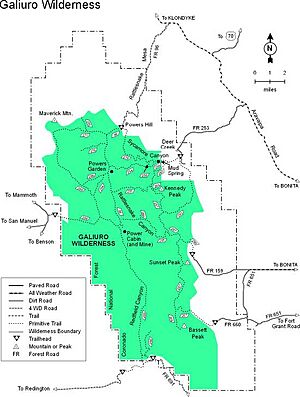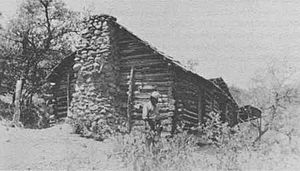Galiuro Wilderness facts for kids
Quick facts for kids Galiuro Wilderness |
|
|---|---|
|
IUCN Category Ib (Wilderness Area)
|
|
| Location | Graham County, Arizona, United States |
| Nearest city | San Manuel, Arizona |
| Area | 76,317 acres (309 km2) |
| Established | 1964 |
| Governing body | U.S. Forest Service |
The Galiuro Wilderness is a special protected area in Arizona, USA. It covers about 76,317 acres (309 km2) of land. This wilderness is part of the Coronado National Forest. It includes the middle and upper parts of the Galiuro Mountains. To its south, you'll find the Redfield Canyon Wilderness. This area is managed by the U.S. Forest Service.
Contents
Exploring Galiuro's Landscape
The Galiuro Wilderness has many different heights. The lowest points are around 4,000 feet (1,219 m) high. The highest point is Bassett Peak, reaching 7,671 feet (2,338 m). The Galiuro Mountains are very rugged and rocky. They have steep cliffs and slopes. These slopes show off brightly colored soils and rocks.
The mountain range is split by two main canyons. These are Rattlesnake Canyon and Redfield Canyon. Some of the tallest peaks here include Bassett Peak and Kennedy Peak. On the western side, you'll find Rhodes Peak and Maverick Mountain.
Plants and Trees of Galiuro
The plants in Galiuro Wilderness change with the elevation. Lower areas have semi-desert grasslands. Higher up, you'll find different types of pine trees.
Many south and west-facing slopes are covered in thick bushes. These include manzanita, live oak, and mahogany. Higher up, you'll see juniper, pinon pine, and oak trees.
In the canyon bottoms and on northern slopes, there are Arizona cypress and Ponderosa pine. You can also find Douglas fir and white fir. Along streams and springs, you'll see sycamore, alder, and maple trees. These areas have water almost all year. Some important springs are Power's Garden and Mud Spring.
Animals of Galiuro Wilderness
Many kinds of animals live in the Galiuro Wilderness. You might spot large mammals like mule deer and pronghorn. There are also desert bighorn sheep and white-tailed deer. Other animals include collared peccary (javelina) and black bear. You might even see a mountain lion.
Smaller animals are also common. These include desert cottontail rabbits and ground squirrels. You can also find raccoons, white-nosed coatis, foxes, and bobcats. For bird watchers, there are quail, doves, and band-tailed pigeons.
A Look at Galiuro's Past
Long ago, the Jacome Indians lived in this area. They were a group possibly related to the Apaches. Later, in the mid-1800s, white settlers arrived. They came to search for minerals and later started mining and ranching.
A famous event happened here in 1918. It involved the Power family, who lived in Rattlesnake Canyon. Jeff Power and his sons, Tom and John, were living there. During World War I, Tom and John were supposed to join the army but did not report.
On February 10, 1918, law enforcement officers came to the Power's cabin. They were there to arrest Tom and John. A gunfight broke out. Four people died in the shootout: Sheriff Robert F. McBride, two deputies, and Jeff Power. The Power sons and their hired man, Tom Sisson, fled to Mexico. They later surrendered to the United States Army.
At their trial, the three men were found responsible for the deaths. They were sentenced to prison for life. Tom Sisson died in prison many years later. The Power brothers were released in 1960. Nine years later, they received a pardon from the governor. The Power's Cabin is now a historic site.
Protecting the Galiuro Mountains
In 1932, a large part of the Galiuro Mountains became a protected area. It was first called the Galiuro Primitive Area. In 1940, it was renamed the Galiuro Wild Area.
When the Wilderness Act was passed in 1964, the area became the Galiuro Wilderness. This law helps protect wild places. A final addition in 1983 made the wilderness even larger. Today, it covers 76,317 acres (309 km2).
In 1943, during World War II, a B-24 bomber crashed near Bassett Peak. All eleven men on board died. A plaque on one of the plane's wings remembers them.
Images for kids





